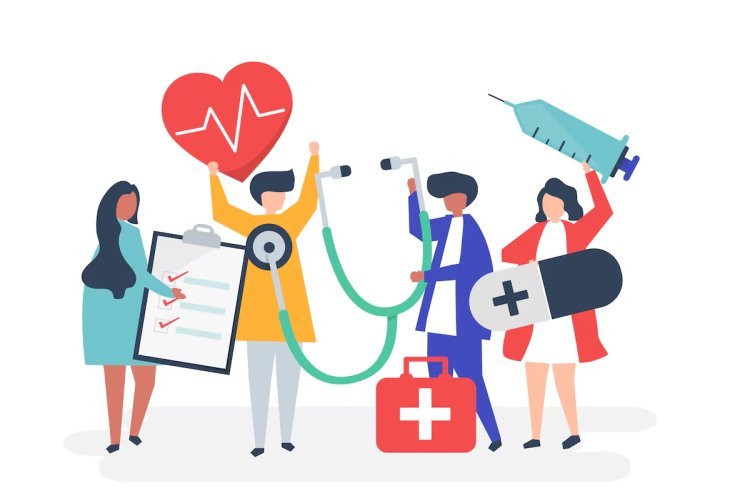Telemedicine Apps: How They’re Shaping the Future of Remote Healthcare

In recent years, telemedicine apps have emerged as a groundbreaking innovation in the healthcare industry. These apps are enabling healthcare professionals to provide remote care to patients, eliminating many of the challenges traditionally associated with in-person visits. Whether it’s consulting with a doctor for a routine checkup, seeking a second opinion, or managing chronic conditions, telemedicine apps have opened the doors to a more convenient, accessible, and cost-effective way of delivering healthcare services.
This article explores how telemedicine apps are shaping the future of healthcare, their benefits, and the critical role of healthcare app development companies in creating these transformative solutions.
The Rise of Telemedicine: A Changing Landscape
Telemedicine refers to the use of digital platforms, including apps, to provide healthcare services remotely. These apps allow for live video consultations, voice calls, text messaging, and even the sharing of medical documents and test results in real-time. Although telemedicine has been around for several decades, it gained significant momentum during the COVID-19 pandemic, when social distancing and lockdown measures made in-person doctor visits nearly impossible for many people.
According to reports, the global telemedicine market size was valued at $62.45 billion in 2020 and is projected to grow at a compound annual growth rate (CAGR) of 23.5% from 2021 to 2028. This rapid growth can be attributed to several factors:
-
Increased smartphone usage: With smartphones becoming ubiquitous, patients and healthcare providers now have access to the technology required for telemedicine right at their fingertips. Mobile apps allow for easy interaction, making healthcare services accessible anytime, anywhere.
-
The need for remote healthcare: The pandemic highlighted the need for remote consultations to avoid exposure to COVID-19. Telemedicine apps ensured continuity of care while keeping patients and healthcare professionals safe.
-
Rural healthcare access: Telemedicine apps are particularly beneficial for patients living in rural or underserved areas where healthcare facilities and specialists are limited. These apps bridge the gap between patients and healthcare providers, allowing individuals in remote locations to receive quality care.
-
Cost-effectiveness: Remote consultations are often more affordable than in-person visits. For healthcare providers, telemedicine reduces overhead costs such as office space and staff. For patients, telemedicine can lower the cost of travel and lost wages due to time off work.
Benefits of Telemedicine Apps
Telemedicine apps have revolutionized the healthcare experience for both patients and providers. Below are some of the key benefits:
1. Improved Access to Care
Telemedicine makes healthcare more accessible, especially for people in rural areas or those with mobility issues. By using telemedicine apps, patients no longer need to travel long distances to consult with a specialist. They can connect with a healthcare provider remotely, saving time, money, and effort.
2. Convenience and Flexibility
Telemedicine apps allow patients to schedule consultations at their convenience, eliminating the need to take time off work or arrange childcare for an in-person visit. This is particularly advantageous for busy individuals or those with chronic conditions that require regular follow-ups.
3. Quality of Care
Contrary to the misconception that telemedicine cannot provide the same level of care as in-person visits, research has shown that telemedicine can be just as effective in many cases. Doctors can assess symptoms, review test results, and provide prescriptions or referrals based on the virtual consultation. Moreover, telemedicine enables healthcare professionals to monitor patients' health remotely, track progress, and intervene when necessary.
4. Cost Savings
Both patients and healthcare providers benefit from the cost-effectiveness of telemedicine apps. Patients can avoid transportation costs and long waiting times, while healthcare providers save on operational expenses. Additionally, telemedicine has been shown to reduce the overall cost of healthcare by minimizing unnecessary hospital visits and streamlining care delivery.
5. Enhanced Patient Engagement
Telemedicine apps often come with features that allow patients to track their health, set reminders for medication, and receive follow-up care instructions. This encourages patient engagement and ensures that individuals stay on top of their health management, which is especially important for those managing chronic conditions like diabetes or hypertension.
6. Reduced Risk of Infection
For patients with compromised immune systems or those suffering from contagious illnesses, telemedicine apps provide a safe alternative to visiting crowded clinics or hospitals. Remote consultations reduce the exposure to infectious diseases, benefiting both patients and healthcare workers.
How Telemedicine Apps are Shaping the Future of Healthcare
Telemedicine is poised to play an even more significant role in the future of healthcare, reshaping how medical services are delivered across the globe. Here are some key ways in which telemedicine apps are influencing the future:
1. Integration of AI and Machine Learning
The integration of Artificial Intelligence (AI) and Machine Learning (ML) technologies in telemedicine apps is revolutionizing diagnostic capabilities. AI-powered tools can analyze medical data such as images, test results, and patient history to assist healthcare providers in making accurate diagnoses. For example, AI can help detect early signs of diseases like cancer or heart conditions, improving patient outcomes through timely interventions.
Moreover, machine learning algorithms can enhance the personalization of care by predicting patient needs, identifying patterns in health data, and suggesting individualized treatment plans.
2. Telemedicine for Mental Health
Mental health is another area where telemedicine apps are having a profound impact. With the growing awareness around mental health issues, telemedicine platforms provide a private, safe space for patients to connect with therapists, counselors, and psychiatrists remotely. Virtual mental health services reduce the stigma associated with seeking treatment and make therapy more accessible to those who might otherwise be hesitant to seek help in person.
3. Remote Patient Monitoring (RPM)
The rise of wearable devices and IoT (Internet of Things) technology is contributing to the development of Remote Patient Monitoring (RPM) systems. These systems enable healthcare providers to monitor patients' vital signs and health data in real-time, even when they’re at home. For instance, wearable heart monitors, glucose meters, and blood pressure cuffs can send data directly to the healthcare provider’s system, allowing for continuous monitoring and timely interventions.
4. Expanded Global Healthcare Access
Telemedicine apps are also playing a pivotal role in making healthcare services available in low-income and developing regions, where access to medical facilities and specialists is often limited. With the help of telemedicine, healthcare providers can remotely diagnose and treat patients in underserved areas, creating a more equitable healthcare system.
Role of Healthcare App Development Companies
As the demand for telemedicine apps continues to grow, the role of healthcare app development companies becomes increasingly critical. These companies specialize in creating tailored solutions that are user-friendly, secure, and compliant with healthcare regulations.
Key responsibilities of healthcare app development companies include:
-
User-Centered Design: Telemedicine apps must be easy to use for patients of all ages and technical abilities. App developers prioritize creating intuitive, responsive, and accessible designs to ensure a seamless user experience.
-
Security and Privacy: Since telemedicine apps deal with sensitive patient data, ensuring robust security measures is crucial. Healthcare app development companies implement encryption, secure login systems, and compliance with regulations like HIPAA (Health Insurance Portability and Accountability Act) to safeguard patient information.
-
Integration with Healthcare Systems: Telemedicine apps often need to integrate with existing Electronic Health Records (EHR) systems, lab databases, and pharmacy platforms to provide comprehensive care. Developers ensure that these integrations are smooth, enhancing the functionality of the app.
-
Customization: Different healthcare providers and institutions have unique requirements. App development companies work closely with healthcare organizations to customize telemedicine platforms, incorporating features like online appointment scheduling, prescription management, and video consultations.
Conclusion
Telemedicine apps are transforming the way healthcare is delivered and are helping bridge the gap between patients and healthcare providers, making medical services more accessible, cost-effective, and convenient. With continued advancements in technology, such as AI integration and remote patient monitoring, telemedicine is set to become an even more integral part of the healthcare system.
The role of healthcare app development companies in building secure, user-friendly, and compliant telemedicine apps is paramount to the success of this sector. These companies are shaping the future of healthcare by enabling a more connected and patient-centered approach to medical care.
What's Your Reaction?













